Critical Analysis of Leadership Theories and Practices
VerifiedAdded on 2021/02/19
|8
|2449
|220
Report
AI Summary
This report offers a critical analysis of leadership, examining two peer-reviewed journal articles. It explores the definition of leadership as a process of influencing and guiding members to achieve organizational goals, and discusses the importance of adapting leadership styles to different generations, particularly millennials. The report delves into evolutionary and strategic leadership theories, highlighting their assumptions, strengths, and weaknesses. It provides examples of how these theories can be applied in practice, focusing on the impact of leadership on employee behavior, motivation, and performance. The analysis also considers the challenges of managing diverse workforces in international business settings and emphasizes the need for leaders to possess adequate knowledge and competencies to guide subordinates effectively, ultimately concluding that leadership styles must evolve with the changing business environment and the needs of the workforce.
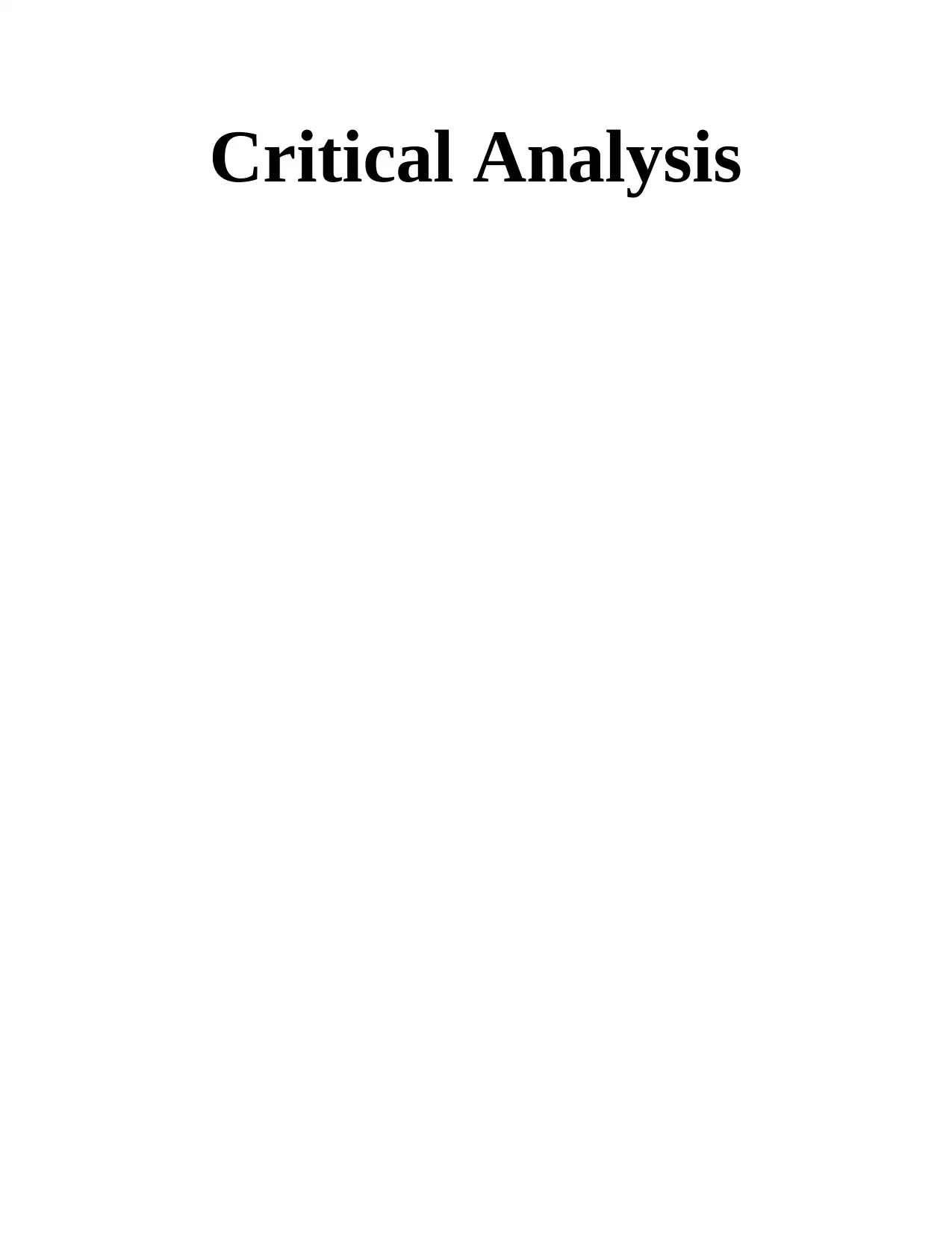
Critical Analysis
Paraphrase This Document
Need a fresh take? Get an instant paraphrase of this document with our AI Paraphraser
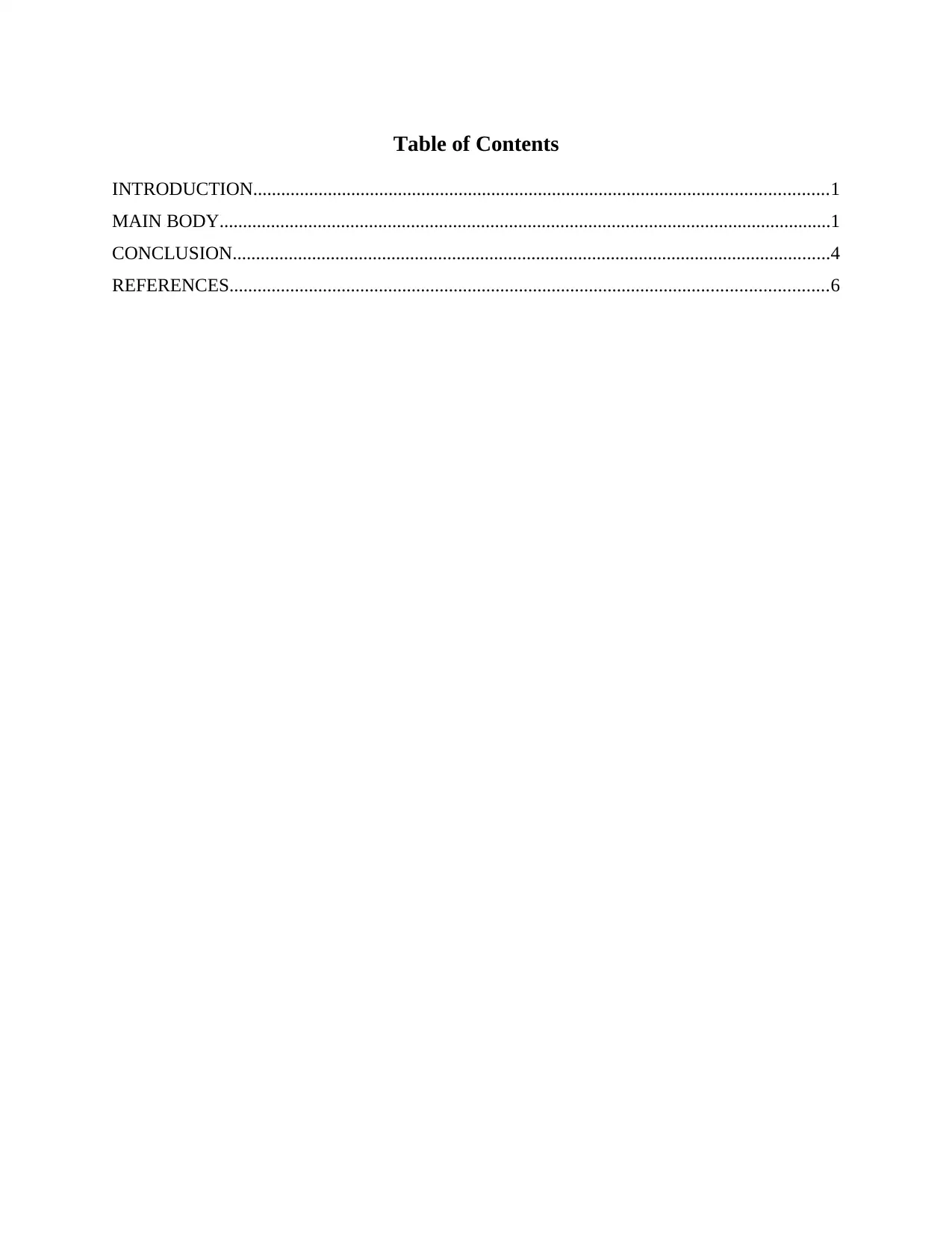
Table of Contents
INTRODUCTION...........................................................................................................................1
MAIN BODY...................................................................................................................................1
CONCLUSION................................................................................................................................4
REFERENCES................................................................................................................................6
INTRODUCTION...........................................................................................................................1
MAIN BODY...................................................................................................................................1
CONCLUSION................................................................................................................................4
REFERENCES................................................................................................................................6
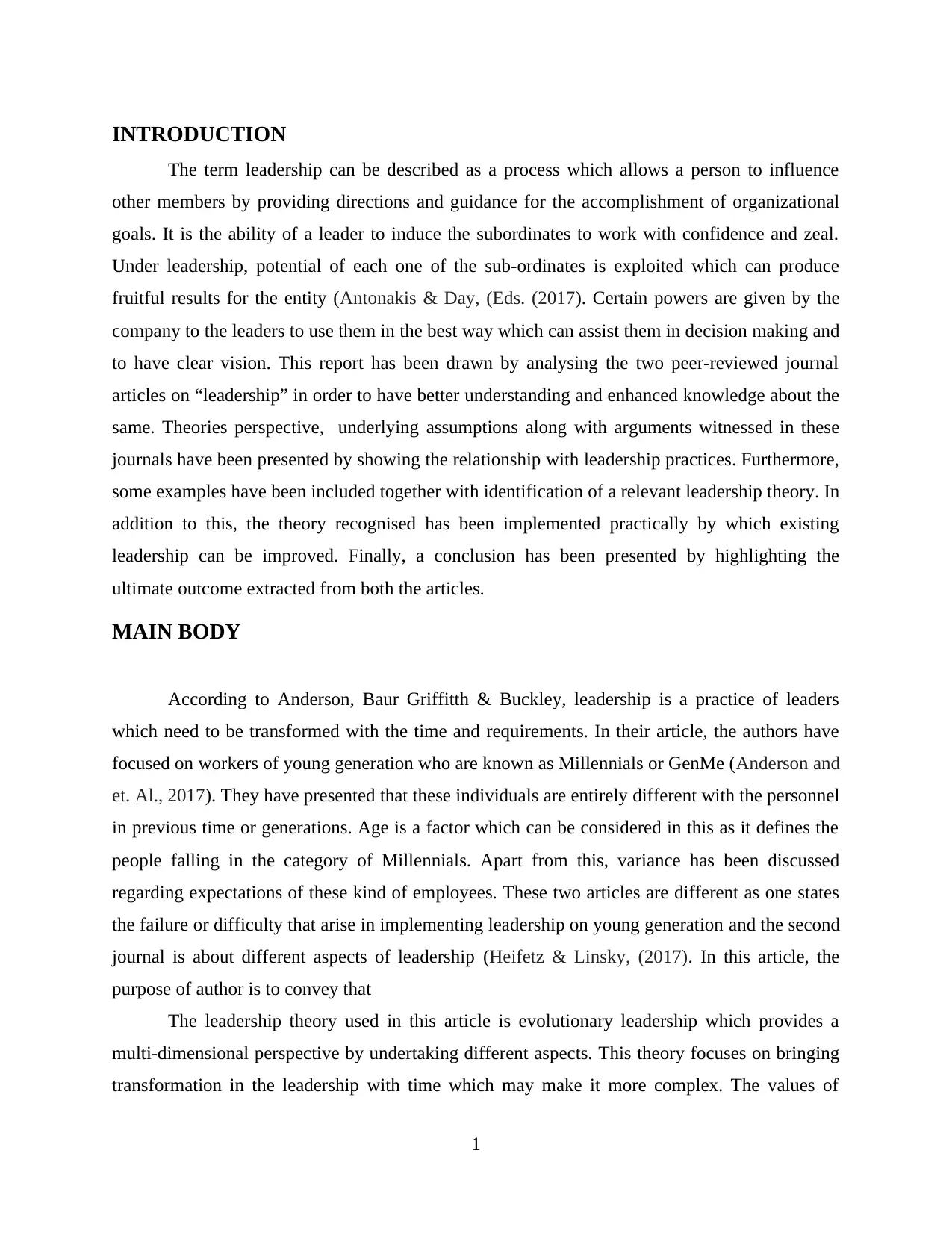
INTRODUCTION
The term leadership can be described as a process which allows a person to influence
other members by providing directions and guidance for the accomplishment of organizational
goals. It is the ability of a leader to induce the subordinates to work with confidence and zeal.
Under leadership, potential of each one of the sub-ordinates is exploited which can produce
fruitful results for the entity (Antonakis & Day, (Eds. (2017). Certain powers are given by the
company to the leaders to use them in the best way which can assist them in decision making and
to have clear vision. This report has been drawn by analysing the two peer-reviewed journal
articles on “leadership” in order to have better understanding and enhanced knowledge about the
same. Theories perspective, underlying assumptions along with arguments witnessed in these
journals have been presented by showing the relationship with leadership practices. Furthermore,
some examples have been included together with identification of a relevant leadership theory. In
addition to this, the theory recognised has been implemented practically by which existing
leadership can be improved. Finally, a conclusion has been presented by highlighting the
ultimate outcome extracted from both the articles.
MAIN BODY
According to Anderson, Baur Griffitth & Buckley, leadership is a practice of leaders
which need to be transformed with the time and requirements. In their article, the authors have
focused on workers of young generation who are known as Millennials or GenMe (Anderson and
et. Al., 2017). They have presented that these individuals are entirely different with the personnel
in previous time or generations. Age is a factor which can be considered in this as it defines the
people falling in the category of Millennials. Apart from this, variance has been discussed
regarding expectations of these kind of employees. These two articles are different as one states
the failure or difficulty that arise in implementing leadership on young generation and the second
journal is about different aspects of leadership (Heifetz & Linsky, (2017). In this article, the
purpose of author is to convey that
The leadership theory used in this article is evolutionary leadership which provides a
multi-dimensional perspective by undertaking different aspects. This theory focuses on bringing
transformation in the leadership with time which may make it more complex. The values of
1
The term leadership can be described as a process which allows a person to influence
other members by providing directions and guidance for the accomplishment of organizational
goals. It is the ability of a leader to induce the subordinates to work with confidence and zeal.
Under leadership, potential of each one of the sub-ordinates is exploited which can produce
fruitful results for the entity (Antonakis & Day, (Eds. (2017). Certain powers are given by the
company to the leaders to use them in the best way which can assist them in decision making and
to have clear vision. This report has been drawn by analysing the two peer-reviewed journal
articles on “leadership” in order to have better understanding and enhanced knowledge about the
same. Theories perspective, underlying assumptions along with arguments witnessed in these
journals have been presented by showing the relationship with leadership practices. Furthermore,
some examples have been included together with identification of a relevant leadership theory. In
addition to this, the theory recognised has been implemented practically by which existing
leadership can be improved. Finally, a conclusion has been presented by highlighting the
ultimate outcome extracted from both the articles.
MAIN BODY
According to Anderson, Baur Griffitth & Buckley, leadership is a practice of leaders
which need to be transformed with the time and requirements. In their article, the authors have
focused on workers of young generation who are known as Millennials or GenMe (Anderson and
et. Al., 2017). They have presented that these individuals are entirely different with the personnel
in previous time or generations. Age is a factor which can be considered in this as it defines the
people falling in the category of Millennials. Apart from this, variance has been discussed
regarding expectations of these kind of employees. These two articles are different as one states
the failure or difficulty that arise in implementing leadership on young generation and the second
journal is about different aspects of leadership (Heifetz & Linsky, (2017). In this article, the
purpose of author is to convey that
The leadership theory used in this article is evolutionary leadership which provides a
multi-dimensional perspective by undertaking different aspects. This theory focuses on bringing
transformation in the leadership with time which may make it more complex. The values of
1
⊘ This is a preview!⊘
Do you want full access?
Subscribe today to unlock all pages.

Trusted by 1+ million students worldwide
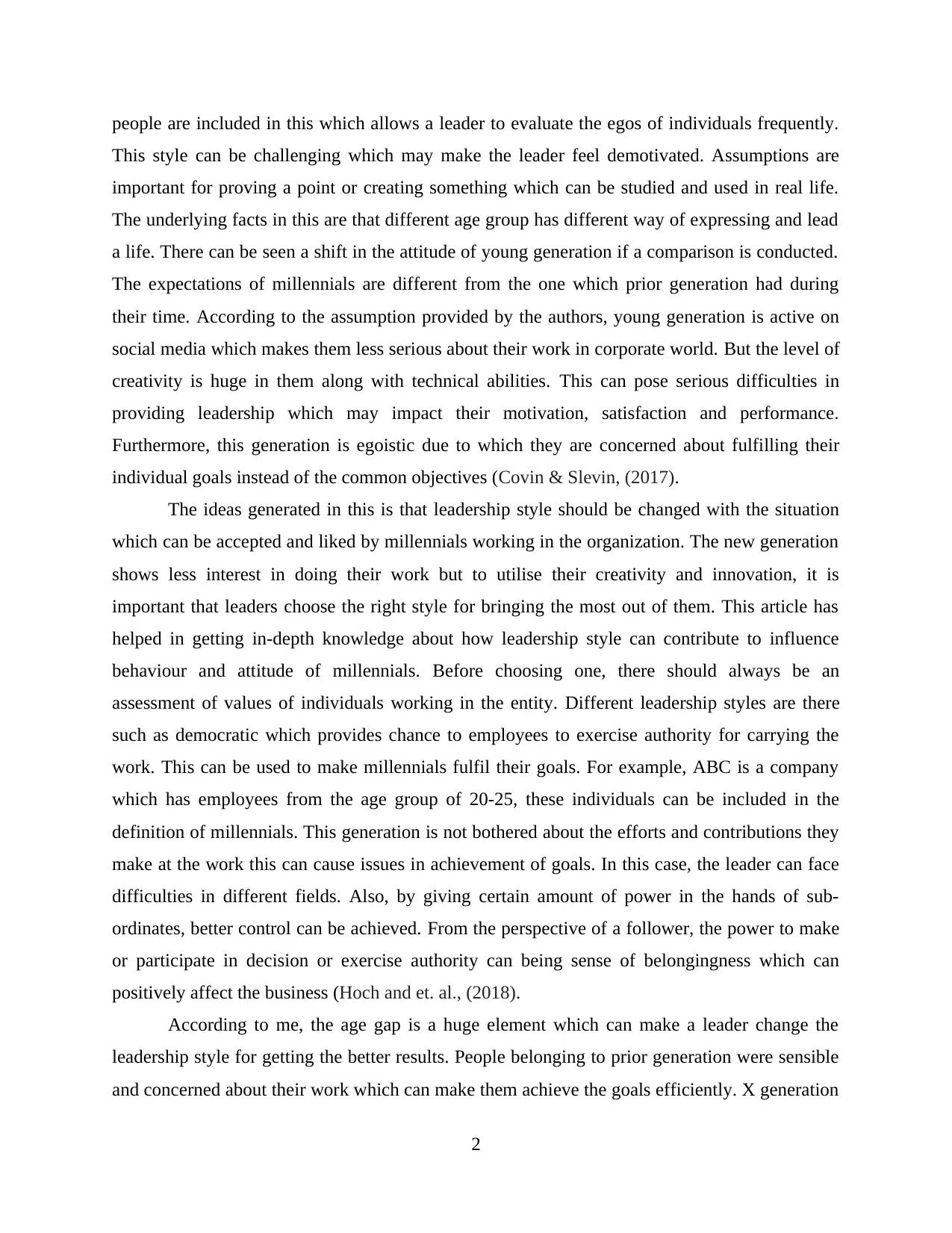
people are included in this which allows a leader to evaluate the egos of individuals frequently.
This style can be challenging which may make the leader feel demotivated. Assumptions are
important for proving a point or creating something which can be studied and used in real life.
The underlying facts in this are that different age group has different way of expressing and lead
a life. There can be seen a shift in the attitude of young generation if a comparison is conducted.
The expectations of millennials are different from the one which prior generation had during
their time. According to the assumption provided by the authors, young generation is active on
social media which makes them less serious about their work in corporate world. But the level of
creativity is huge in them along with technical abilities. This can pose serious difficulties in
providing leadership which may impact their motivation, satisfaction and performance.
Furthermore, this generation is egoistic due to which they are concerned about fulfilling their
individual goals instead of the common objectives (Covin & Slevin, (2017).
The ideas generated in this is that leadership style should be changed with the situation
which can be accepted and liked by millennials working in the organization. The new generation
shows less interest in doing their work but to utilise their creativity and innovation, it is
important that leaders choose the right style for bringing the most out of them. This article has
helped in getting in-depth knowledge about how leadership style can contribute to influence
behaviour and attitude of millennials. Before choosing one, there should always be an
assessment of values of individuals working in the entity. Different leadership styles are there
such as democratic which provides chance to employees to exercise authority for carrying the
work. This can be used to make millennials fulfil their goals. For example, ABC is a company
which has employees from the age group of 20-25, these individuals can be included in the
definition of millennials. This generation is not bothered about the efforts and contributions they
make at the work this can cause issues in achievement of goals. In this case, the leader can face
difficulties in different fields. Also, by giving certain amount of power in the hands of sub-
ordinates, better control can be achieved. From the perspective of a follower, the power to make
or participate in decision or exercise authority can being sense of belongingness which can
positively affect the business (Hoch and et. al., (2018).
According to me, the age gap is a huge element which can make a leader change the
leadership style for getting the better results. People belonging to prior generation were sensible
and concerned about their work which can make them achieve the goals efficiently. X generation
2
This style can be challenging which may make the leader feel demotivated. Assumptions are
important for proving a point or creating something which can be studied and used in real life.
The underlying facts in this are that different age group has different way of expressing and lead
a life. There can be seen a shift in the attitude of young generation if a comparison is conducted.
The expectations of millennials are different from the one which prior generation had during
their time. According to the assumption provided by the authors, young generation is active on
social media which makes them less serious about their work in corporate world. But the level of
creativity is huge in them along with technical abilities. This can pose serious difficulties in
providing leadership which may impact their motivation, satisfaction and performance.
Furthermore, this generation is egoistic due to which they are concerned about fulfilling their
individual goals instead of the common objectives (Covin & Slevin, (2017).
The ideas generated in this is that leadership style should be changed with the situation
which can be accepted and liked by millennials working in the organization. The new generation
shows less interest in doing their work but to utilise their creativity and innovation, it is
important that leaders choose the right style for bringing the most out of them. This article has
helped in getting in-depth knowledge about how leadership style can contribute to influence
behaviour and attitude of millennials. Before choosing one, there should always be an
assessment of values of individuals working in the entity. Different leadership styles are there
such as democratic which provides chance to employees to exercise authority for carrying the
work. This can be used to make millennials fulfil their goals. For example, ABC is a company
which has employees from the age group of 20-25, these individuals can be included in the
definition of millennials. This generation is not bothered about the efforts and contributions they
make at the work this can cause issues in achievement of goals. In this case, the leader can face
difficulties in different fields. Also, by giving certain amount of power in the hands of sub-
ordinates, better control can be achieved. From the perspective of a follower, the power to make
or participate in decision or exercise authority can being sense of belongingness which can
positively affect the business (Hoch and et. al., (2018).
According to me, the age gap is a huge element which can make a leader change the
leadership style for getting the better results. People belonging to prior generation were sensible
and concerned about their work which can make them achieve the goals efficiently. X generation
2
Paraphrase This Document
Need a fresh take? Get an instant paraphrase of this document with our AI Paraphraser
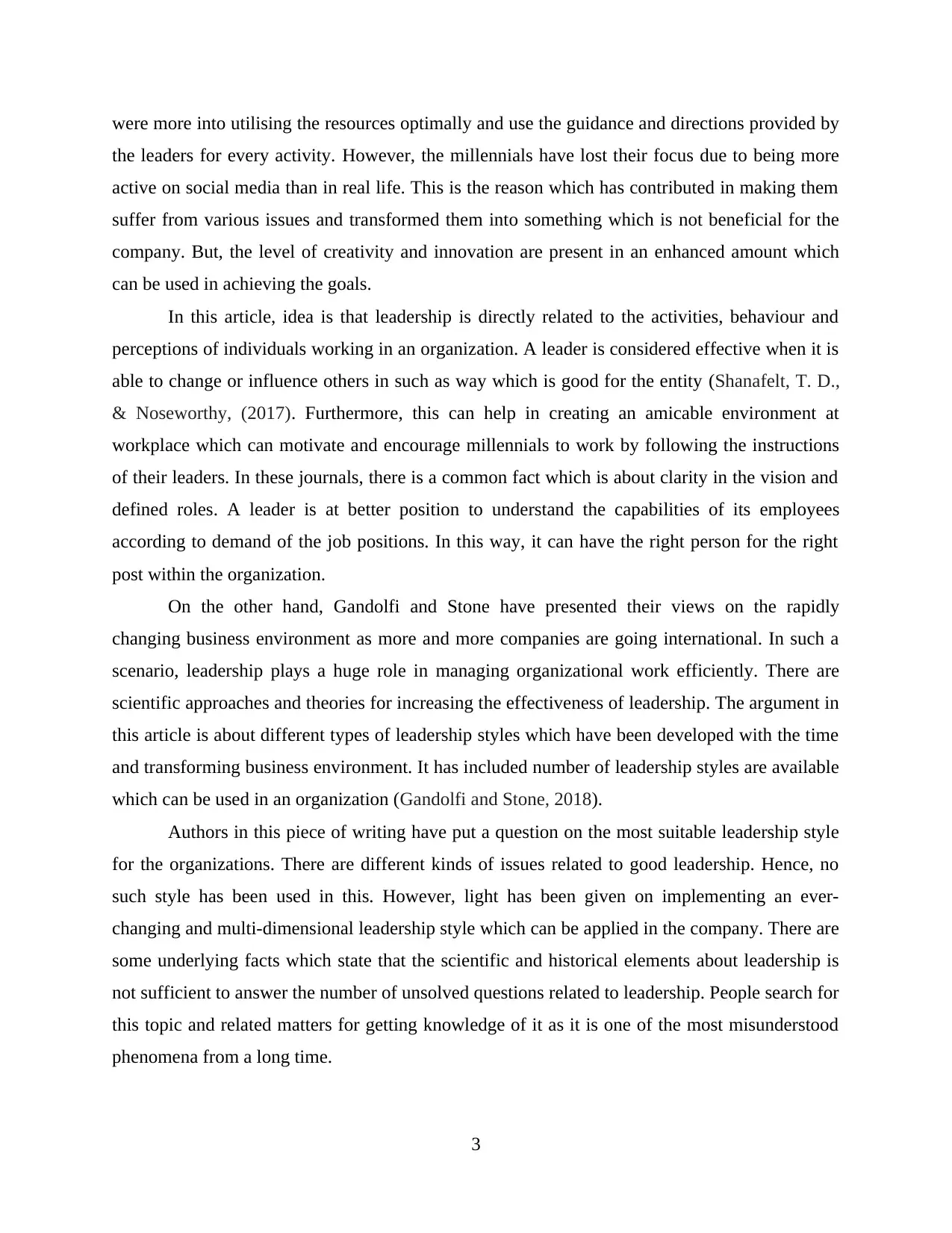
were more into utilising the resources optimally and use the guidance and directions provided by
the leaders for every activity. However, the millennials have lost their focus due to being more
active on social media than in real life. This is the reason which has contributed in making them
suffer from various issues and transformed them into something which is not beneficial for the
company. But, the level of creativity and innovation are present in an enhanced amount which
can be used in achieving the goals.
In this article, idea is that leadership is directly related to the activities, behaviour and
perceptions of individuals working in an organization. A leader is considered effective when it is
able to change or influence others in such as way which is good for the entity (Shanafelt, T. D.,
& Noseworthy, (2017). Furthermore, this can help in creating an amicable environment at
workplace which can motivate and encourage millennials to work by following the instructions
of their leaders. In these journals, there is a common fact which is about clarity in the vision and
defined roles. A leader is at better position to understand the capabilities of its employees
according to demand of the job positions. In this way, it can have the right person for the right
post within the organization.
On the other hand, Gandolfi and Stone have presented their views on the rapidly
changing business environment as more and more companies are going international. In such a
scenario, leadership plays a huge role in managing organizational work efficiently. There are
scientific approaches and theories for increasing the effectiveness of leadership. The argument in
this article is about different types of leadership styles which have been developed with the time
and transforming business environment. It has included number of leadership styles are available
which can be used in an organization (Gandolfi and Stone, 2018).
Authors in this piece of writing have put a question on the most suitable leadership style
for the organizations. There are different kinds of issues related to good leadership. Hence, no
such style has been used in this. However, light has been given on implementing an ever-
changing and multi-dimensional leadership style which can be applied in the company. There are
some underlying facts which state that the scientific and historical elements about leadership is
not sufficient to answer the number of unsolved questions related to leadership. People search for
this topic and related matters for getting knowledge of it as it is one of the most misunderstood
phenomena from a long time.
3
the leaders for every activity. However, the millennials have lost their focus due to being more
active on social media than in real life. This is the reason which has contributed in making them
suffer from various issues and transformed them into something which is not beneficial for the
company. But, the level of creativity and innovation are present in an enhanced amount which
can be used in achieving the goals.
In this article, idea is that leadership is directly related to the activities, behaviour and
perceptions of individuals working in an organization. A leader is considered effective when it is
able to change or influence others in such as way which is good for the entity (Shanafelt, T. D.,
& Noseworthy, (2017). Furthermore, this can help in creating an amicable environment at
workplace which can motivate and encourage millennials to work by following the instructions
of their leaders. In these journals, there is a common fact which is about clarity in the vision and
defined roles. A leader is at better position to understand the capabilities of its employees
according to demand of the job positions. In this way, it can have the right person for the right
post within the organization.
On the other hand, Gandolfi and Stone have presented their views on the rapidly
changing business environment as more and more companies are going international. In such a
scenario, leadership plays a huge role in managing organizational work efficiently. There are
scientific approaches and theories for increasing the effectiveness of leadership. The argument in
this article is about different types of leadership styles which have been developed with the time
and transforming business environment. It has included number of leadership styles are available
which can be used in an organization (Gandolfi and Stone, 2018).
Authors in this piece of writing have put a question on the most suitable leadership style
for the organizations. There are different kinds of issues related to good leadership. Hence, no
such style has been used in this. However, light has been given on implementing an ever-
changing and multi-dimensional leadership style which can be applied in the company. There are
some underlying facts which state that the scientific and historical elements about leadership is
not sufficient to answer the number of unsolved questions related to leadership. People search for
this topic and related matters for getting knowledge of it as it is one of the most misunderstood
phenomena from a long time.
3
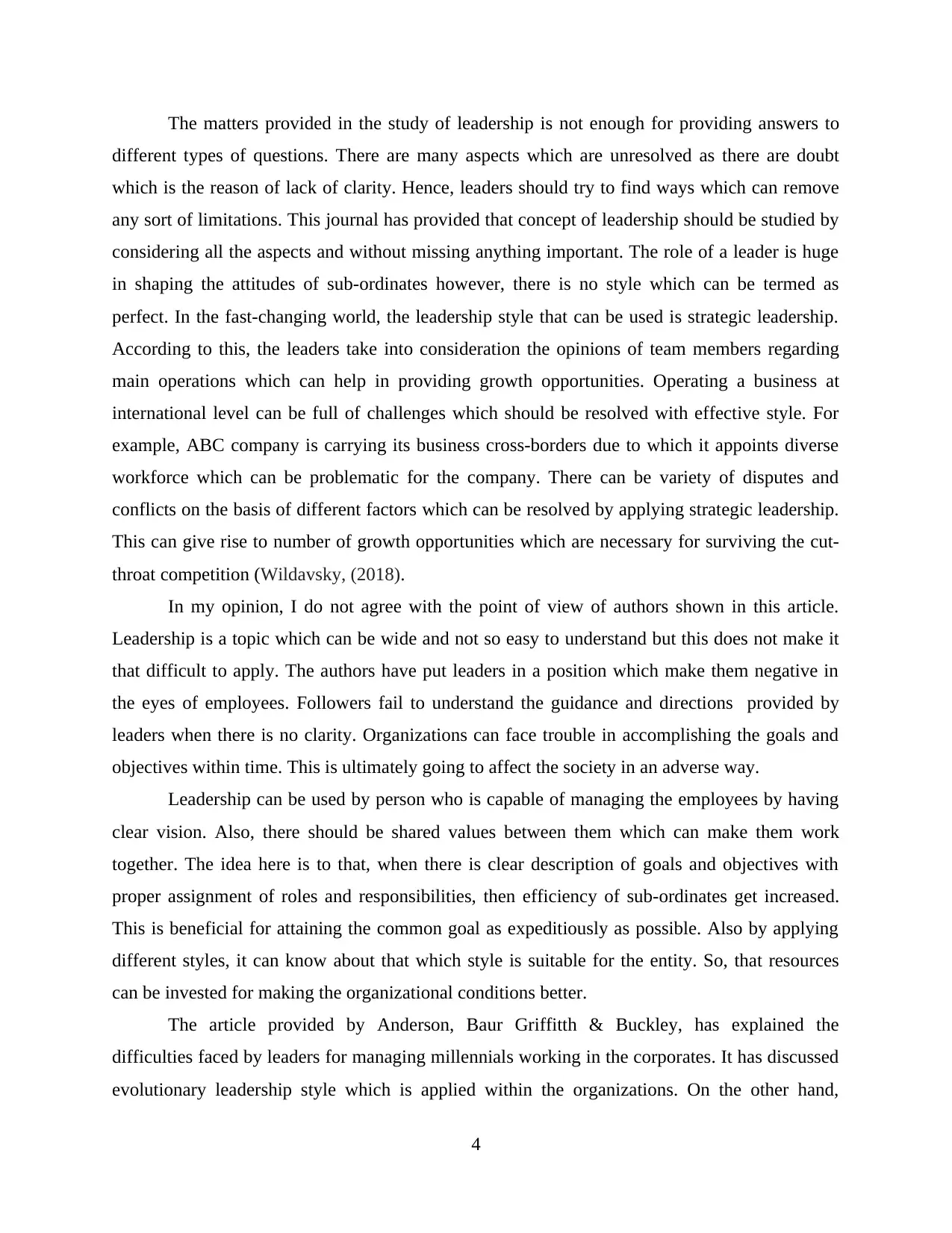
The matters provided in the study of leadership is not enough for providing answers to
different types of questions. There are many aspects which are unresolved as there are doubt
which is the reason of lack of clarity. Hence, leaders should try to find ways which can remove
any sort of limitations. This journal has provided that concept of leadership should be studied by
considering all the aspects and without missing anything important. The role of a leader is huge
in shaping the attitudes of sub-ordinates however, there is no style which can be termed as
perfect. In the fast-changing world, the leadership style that can be used is strategic leadership.
According to this, the leaders take into consideration the opinions of team members regarding
main operations which can help in providing growth opportunities. Operating a business at
international level can be full of challenges which should be resolved with effective style. For
example, ABC company is carrying its business cross-borders due to which it appoints diverse
workforce which can be problematic for the company. There can be variety of disputes and
conflicts on the basis of different factors which can be resolved by applying strategic leadership.
This can give rise to number of growth opportunities which are necessary for surviving the cut-
throat competition (Wildavsky, (2018).
In my opinion, I do not agree with the point of view of authors shown in this article.
Leadership is a topic which can be wide and not so easy to understand but this does not make it
that difficult to apply. The authors have put leaders in a position which make them negative in
the eyes of employees. Followers fail to understand the guidance and directions provided by
leaders when there is no clarity. Organizations can face trouble in accomplishing the goals and
objectives within time. This is ultimately going to affect the society in an adverse way.
Leadership can be used by person who is capable of managing the employees by having
clear vision. Also, there should be shared values between them which can make them work
together. The idea here is to that, when there is clear description of goals and objectives with
proper assignment of roles and responsibilities, then efficiency of sub-ordinates get increased.
This is beneficial for attaining the common goal as expeditiously as possible. Also by applying
different styles, it can know about that which style is suitable for the entity. So, that resources
can be invested for making the organizational conditions better.
The article provided by Anderson, Baur Griffitth & Buckley, has explained the
difficulties faced by leaders for managing millennials working in the corporates. It has discussed
evolutionary leadership style which is applied within the organizations. On the other hand,
4
different types of questions. There are many aspects which are unresolved as there are doubt
which is the reason of lack of clarity. Hence, leaders should try to find ways which can remove
any sort of limitations. This journal has provided that concept of leadership should be studied by
considering all the aspects and without missing anything important. The role of a leader is huge
in shaping the attitudes of sub-ordinates however, there is no style which can be termed as
perfect. In the fast-changing world, the leadership style that can be used is strategic leadership.
According to this, the leaders take into consideration the opinions of team members regarding
main operations which can help in providing growth opportunities. Operating a business at
international level can be full of challenges which should be resolved with effective style. For
example, ABC company is carrying its business cross-borders due to which it appoints diverse
workforce which can be problematic for the company. There can be variety of disputes and
conflicts on the basis of different factors which can be resolved by applying strategic leadership.
This can give rise to number of growth opportunities which are necessary for surviving the cut-
throat competition (Wildavsky, (2018).
In my opinion, I do not agree with the point of view of authors shown in this article.
Leadership is a topic which can be wide and not so easy to understand but this does not make it
that difficult to apply. The authors have put leaders in a position which make them negative in
the eyes of employees. Followers fail to understand the guidance and directions provided by
leaders when there is no clarity. Organizations can face trouble in accomplishing the goals and
objectives within time. This is ultimately going to affect the society in an adverse way.
Leadership can be used by person who is capable of managing the employees by having
clear vision. Also, there should be shared values between them which can make them work
together. The idea here is to that, when there is clear description of goals and objectives with
proper assignment of roles and responsibilities, then efficiency of sub-ordinates get increased.
This is beneficial for attaining the common goal as expeditiously as possible. Also by applying
different styles, it can know about that which style is suitable for the entity. So, that resources
can be invested for making the organizational conditions better.
The article provided by Anderson, Baur Griffitth & Buckley, has explained the
difficulties faced by leaders for managing millennials working in the corporates. It has discussed
evolutionary leadership style which is applied within the organizations. On the other hand,
4
⊘ This is a preview!⊘
Do you want full access?
Subscribe today to unlock all pages.

Trusted by 1+ million students worldwide
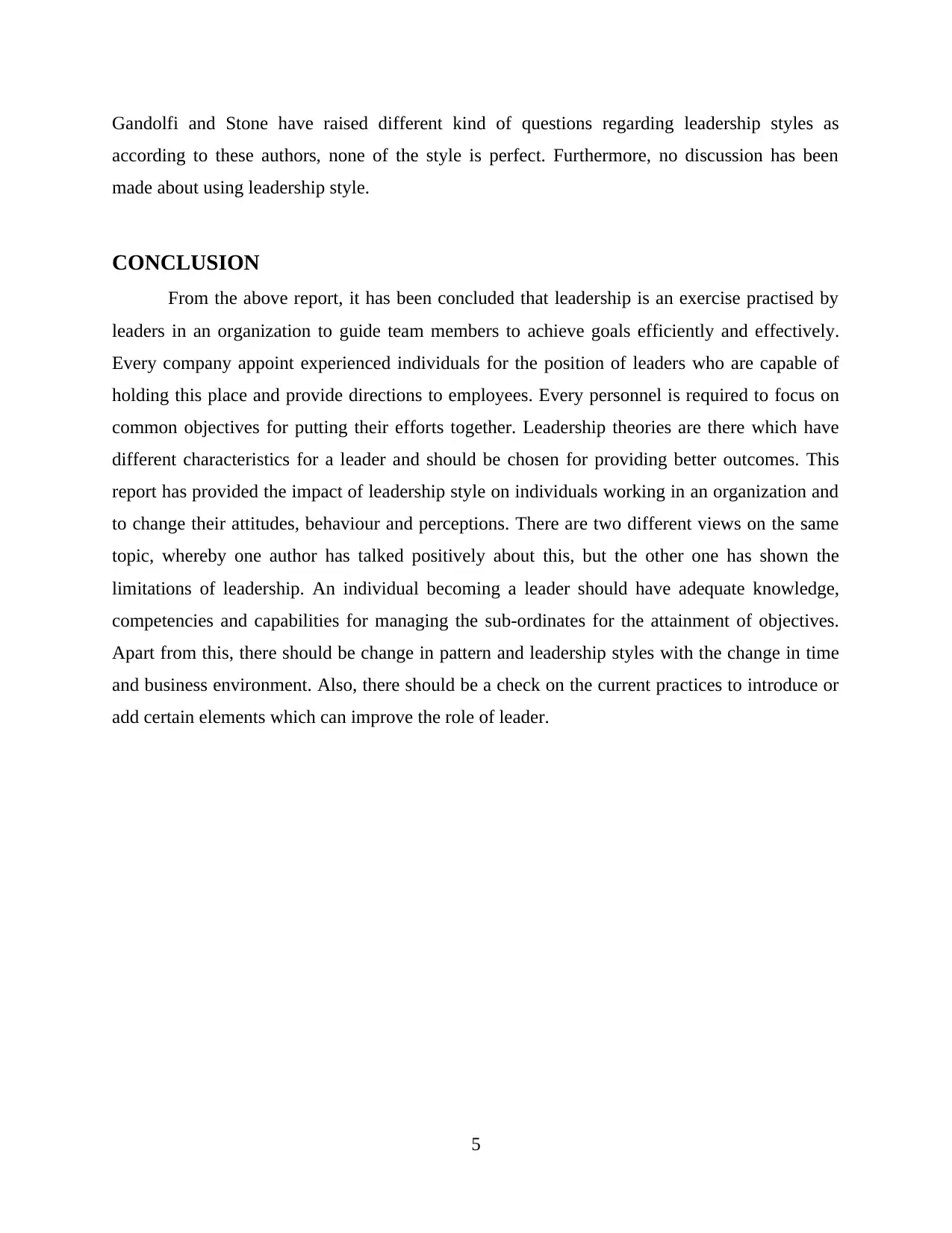
Gandolfi and Stone have raised different kind of questions regarding leadership styles as
according to these authors, none of the style is perfect. Furthermore, no discussion has been
made about using leadership style.
CONCLUSION
From the above report, it has been concluded that leadership is an exercise practised by
leaders in an organization to guide team members to achieve goals efficiently and effectively.
Every company appoint experienced individuals for the position of leaders who are capable of
holding this place and provide directions to employees. Every personnel is required to focus on
common objectives for putting their efforts together. Leadership theories are there which have
different characteristics for a leader and should be chosen for providing better outcomes. This
report has provided the impact of leadership style on individuals working in an organization and
to change their attitudes, behaviour and perceptions. There are two different views on the same
topic, whereby one author has talked positively about this, but the other one has shown the
limitations of leadership. An individual becoming a leader should have adequate knowledge,
competencies and capabilities for managing the sub-ordinates for the attainment of objectives.
Apart from this, there should be change in pattern and leadership styles with the change in time
and business environment. Also, there should be a check on the current practices to introduce or
add certain elements which can improve the role of leader.
5
according to these authors, none of the style is perfect. Furthermore, no discussion has been
made about using leadership style.
CONCLUSION
From the above report, it has been concluded that leadership is an exercise practised by
leaders in an organization to guide team members to achieve goals efficiently and effectively.
Every company appoint experienced individuals for the position of leaders who are capable of
holding this place and provide directions to employees. Every personnel is required to focus on
common objectives for putting their efforts together. Leadership theories are there which have
different characteristics for a leader and should be chosen for providing better outcomes. This
report has provided the impact of leadership style on individuals working in an organization and
to change their attitudes, behaviour and perceptions. There are two different views on the same
topic, whereby one author has talked positively about this, but the other one has shown the
limitations of leadership. An individual becoming a leader should have adequate knowledge,
competencies and capabilities for managing the sub-ordinates for the attainment of objectives.
Apart from this, there should be change in pattern and leadership styles with the change in time
and business environment. Also, there should be a check on the current practices to introduce or
add certain elements which can improve the role of leader.
5
Paraphrase This Document
Need a fresh take? Get an instant paraphrase of this document with our AI Paraphraser
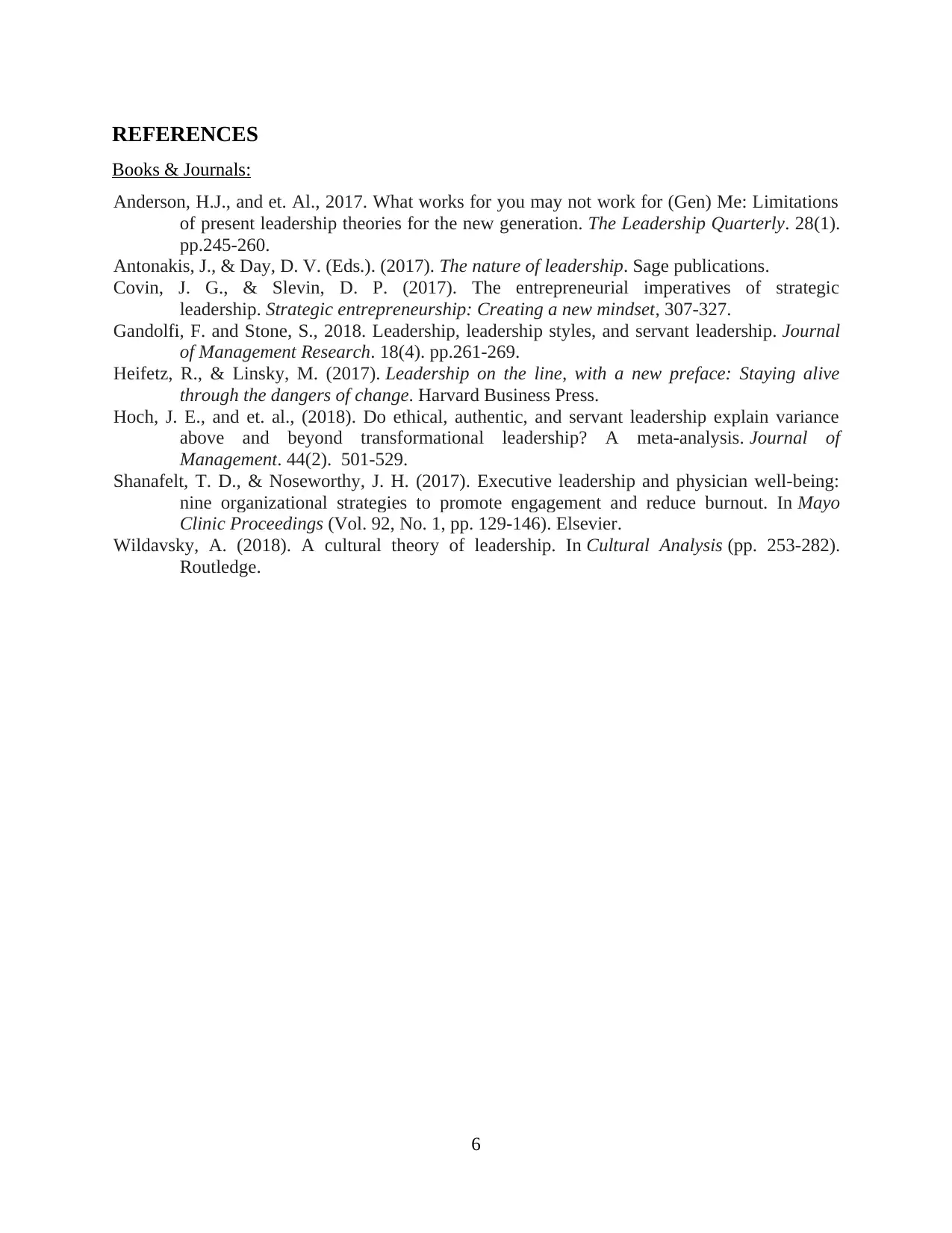
REFERENCES
Books & Journals:
Anderson, H.J., and et. Al., 2017. What works for you may not work for (Gen) Me: Limitations
of present leadership theories for the new generation. The Leadership Quarterly. 28(1).
pp.245-260.
Antonakis, J., & Day, D. V. (Eds.). (2017). The nature of leadership. Sage publications.
Covin, J. G., & Slevin, D. P. (2017). The entrepreneurial imperatives of strategic
leadership. Strategic entrepreneurship: Creating a new mindset, 307-327.
Gandolfi, F. and Stone, S., 2018. Leadership, leadership styles, and servant leadership. Journal
of Management Research. 18(4). pp.261-269.
Heifetz, R., & Linsky, M. (2017). Leadership on the line, with a new preface: Staying alive
through the dangers of change. Harvard Business Press.
Hoch, J. E., and et. al., (2018). Do ethical, authentic, and servant leadership explain variance
above and beyond transformational leadership? A meta-analysis. Journal of
Management. 44(2). 501-529.
Shanafelt, T. D., & Noseworthy, J. H. (2017). Executive leadership and physician well-being:
nine organizational strategies to promote engagement and reduce burnout. In Mayo
Clinic Proceedings (Vol. 92, No. 1, pp. 129-146). Elsevier.
Wildavsky, A. (2018). A cultural theory of leadership. In Cultural Analysis (pp. 253-282).
Routledge.
6
Books & Journals:
Anderson, H.J., and et. Al., 2017. What works for you may not work for (Gen) Me: Limitations
of present leadership theories for the new generation. The Leadership Quarterly. 28(1).
pp.245-260.
Antonakis, J., & Day, D. V. (Eds.). (2017). The nature of leadership. Sage publications.
Covin, J. G., & Slevin, D. P. (2017). The entrepreneurial imperatives of strategic
leadership. Strategic entrepreneurship: Creating a new mindset, 307-327.
Gandolfi, F. and Stone, S., 2018. Leadership, leadership styles, and servant leadership. Journal
of Management Research. 18(4). pp.261-269.
Heifetz, R., & Linsky, M. (2017). Leadership on the line, with a new preface: Staying alive
through the dangers of change. Harvard Business Press.
Hoch, J. E., and et. al., (2018). Do ethical, authentic, and servant leadership explain variance
above and beyond transformational leadership? A meta-analysis. Journal of
Management. 44(2). 501-529.
Shanafelt, T. D., & Noseworthy, J. H. (2017). Executive leadership and physician well-being:
nine organizational strategies to promote engagement and reduce burnout. In Mayo
Clinic Proceedings (Vol. 92, No. 1, pp. 129-146). Elsevier.
Wildavsky, A. (2018). A cultural theory of leadership. In Cultural Analysis (pp. 253-282).
Routledge.
6
1 out of 8
Related Documents
Your All-in-One AI-Powered Toolkit for Academic Success.
+13062052269
info@desklib.com
Available 24*7 on WhatsApp / Email
![[object Object]](/_next/static/media/star-bottom.7253800d.svg)
Unlock your academic potential
Copyright © 2020–2025 A2Z Services. All Rights Reserved. Developed and managed by ZUCOL.





